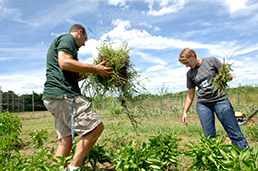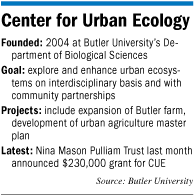Subscriber Benefit
As a subscriber you can listen to articles at work, in the car, or while you work out. Subscribe Now Students tend to Butler University’s farm, which will be expanded. (IBJ Photo/ Perry Reichanadter)
Students tend to Butler University’s farm, which will be expanded. (IBJ Photo/ Perry Reichanadter)Urban ecology seems about as far removed from the local economy as is the mold infections of salamander eggs at Eagle Creek Park.
But Butler University’s Center for Urban Ecology, which did the seemingly esoteric mold study, is determined to make its work valuable on a broad scale.
Says CUE Director Tim Carter: “We don’t want to be in the Butler University ivory tower. We want to do things that are meaningful on the ground.”
Carter, who joined the center in 2009, is intent on making CUE a national leader in urban ecology.
 Carter
CarterHe thinks the center can do that by, for example, making urban farming a viable business—a goal that will start with more than doubling the size of Butler’s campus farm.
Carter, meanwhile, is brimming with other ideas.
One is to create a “living building” at Holcomb Gardens, on the Butler campus. It would be one of just five such buildings in the world that produce more energy than they consume. A design competition is likely to be announced later this year.
Or how about working with the city to create an urban bird trail along connected green spaces in the city?
CUE’s efforts got a big boost in July when it learned it would receive $230,000 over three years from the Nina Mason Pulliam Charitable Trust.
Part of the grant will be used to develop an urban agriculture master plan for the city. Some of the money will be used for an outreach to local schools to help them integrate sustainable agriculture into their science curriculum, based on practices at Butler’s farm.
Down on the farm
Carter’s crew isn’t the first to point out that urban farms on sub-acre plots could reclaim weed-covered, junk-strewn lots and sell produce to grocery stores and restaurants literally down the street.
 Those businesses, in turn, could generate more money by catering to customers wanting fresher produce with a smaller carbon footprint. After all, such crops wouldn’t have to be trucked in from long distances.
Those businesses, in turn, could generate more money by catering to customers wanting fresher produce with a smaller carbon footprint. After all, such crops wouldn’t have to be trucked in from long distances.
This kind of thing may be viable in the hippie enclaves of Boston or New York. But surely it’s too hip for Indianapolis?
Actually, Carter may be on to something.
As of last year, the city had at least one urban farmer—Matthew Jose, who operates Broad Ripple-based Big City Farms LLC. He sells his basil, beans, carrots, onions and other crops to individuals and restaurants, including City Café and R Bistro, both of which are locally owned.
So far, farming on small plots isn’t lucrative. Besides small production volumes, some plots in the inner city are soiled with lead and other industrial contaminants. And if urban farming were easy, a lot of people would be doing it, Carter noted.
“I think the jury is still out on whether people in urban agriculture can make a decent living,” said David Forsell, president of Keep Indianapolis Beautiful, who has been supportive of the work by the Butler CUE.
Cultivating ideas
CUE’s students, in disciplines ranging from business to education to the sciences, are looking at innovative ways to cultivate the urban farming business.
Might, for example, a deal be struck with the city to provide a break on water costs? Might a case be made for corporate support, given that a more attractive and vibrant city could make it easier to recruit employees here?
The center is also pondering issues such as which areas of the city are most ripe for urban farming and whether it would make sense to create and promote a brand for “Indy-grown” produce.
Or might there be growing techniques that could make small plots more efficient?
“What attracted me to this city was how many opportunities there are,” Carter said.
A native of Waynesboro, Pa., Carter received his doctorate from the University of Georgia, where he evaluated vegetated roofs for urban eco system remediation.
Butler formed the Center for Urban Ecology in 2004, out of the Department of Biological Sciences. Carter has helped draw in students from other disciplines, such as a business student who recently developed a sub-acre urban farm plot.
A chemistry student, meanwhile, developed a biodiesel blend from vegetable oil that will be used to fuel diesel-powered vehicles on campus. The blend might even provide commercial opportunities.
Meanwhile, Butler CUE brought in students from various disciplines to help develop an app for mobile devices that, using GPS data, allows a user to map a raindrop’s path from his home to the White River watershed. The Raindrop app, developed in a partnership with a New York studio and Indianapolis-based Williams Creek Consulting, makes users aware of flow paths as well as pollution constituents along the way.
“We like to talk a lot about relevance,” Carter said of the center’s approach.
Partnerships sought
This urban ecology thing isn’t necessarily well understood by the masses.
In the past, it was defined narrowly as the study of animals and plants in urban areas and, basically, how humans are screwing up the ecosystem.
Carter prefers the idea that the city itself must be viewed as an ecosystem, one that recognizes the complexities that humans bring. How do you improve the habitat to benefit all critters alike, including humans?
“In the city, we have to think about ecology in the context of the economy,” said KIB’s Forsell, who in some ways is a kindred spirit with Carter.
For example, on the human front, KIB has a tree program that gives high school students a chance to earn $8 an hour by taking care of trees, such as watering and pruning them. Forsell wonders if there are ways to engage Butler CUE students in future projects.
Already, CUE students have been working with KIB to study the ecological effects of 12 acres of plantings KIB and Eli Lilly and Co. volunteers installed along Interstate 70, west of downtown, over the last two years.
Forsell said CUE students have literally been vacuuming up bugs and collecting other samples from the new vegetation along the interstate. The three-year study will determine whether the work improved the local eco system—beyond making aesthetic improvements.
“What [Butler CUE students] bring is a research capability,” Forsell said. The Butler center “is sort of coming into its own.”•
Please enable JavaScript to view this content.
